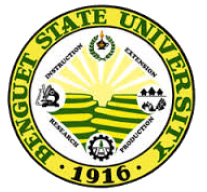BSU RESEARCH JOURNAL ...

BSU RESEARCH JOURNAL
Benguet State University
RESEARCH JOURNAL
ISSN 0117-5297 No. 70 July-December 2013
TABLE OF CONTENTS
IN-SITU MORPHOLOGICAL CHARACTERIZATION
AND DIVERISTY ANALYSIS IN TRADITIONAL
ARABICA CULTIVARS IN BENGUET. . . . . . . . . . . . . . . . . . . . . . . . . . . 1-33
B. A. Tad-awan and J.D. Doco
GROWING AREAS AND TRADIITONAL PRODUCTION PRACTICES
OF ARABICA COFFEE IN BENGUET. . . . . . . . . . . .. . . . . . . . . . . . . . . 34-63
70 July-December 2013
B. A. Tad-awan, V. Y. Amado and J. D. Doco
DEVELOPMENT OF SUSTAINABLE DISEASE MANAGEMENT
STRATEGIES IN STRAWBERRY PRODUCTION
IN BENGUET, PHILIPPINES: A REVIEW. . . . . . . . . .. . . . . . . . . . . . . . 64-87
L. M. Villanueva
PHATOLOGIC REACTION OF GARDEN PEA (Pisum sativum L.)
CULTIVARS/ADVANCED BREEDING LINES TO ROOT-KNOT
NEMATODE, Meloidogyne incognita (KOFOID AND WHITE)
CHITWOOD . . . . . . . . . . . . . . . . . . . . . . . . . . . . . . . . . . . . . . . . . . . . . . 88-101
J. R. P. Dimaguiba and L. M. Villanueva
BENGUET STATE UNIVERSITY
La Trinidad 2601 Benguet
Philippines
All communications should be addressed to:
THE EDITOR
BSU Research Journal
Benguet State Univeristy
La Trinidad, Benguet 2601, Philippines
Telefax:( +6374) 422-5547
Email address: bsupublications@gmail.com
repo@bsu.edu.ph
Website: www.bsu.edu.ph

Benguet State University
RESEARCH JOURNAL
This multidisciplinary scientific journal publishes selected
papers but not limited to those presented during the
annual Benguet State University Agency In-House Review
(Agriculture, Forestry and Natural Resources, Social and
Education Sectors).
Editorial Board
Luciana M. Villanueva
Editor-in-Chief
Vice President for Research and Extension
Christine Grace B. Sidchogan
Marie Fe B. Wance
Lay-out Artist/ Circulations Assistant
Technical Editors
Terisita Mangili
Nancy Bantog
Dado Estigoy
Percival B. Alipit
Esther Botangen
Leoncia Tandang
Danilo Padua
Valentino Macanes
Editorial Consultants:
Ben D. Ladilad
President
Eulogio Cardona Jr.
Director of Research Services
Gilda B. Jacalan
English Critique
This is a refereed Journal
Benguet State University Research Journal (BRJ) July-December 2013, 70: 1-33
Copyright 2013, Benguet State University
IN-SITU MORPHOLOGICAL CHARACTERIZATION AND DIVERSITY
ANALYSIS IN TRADITIONAL ARABICA CULTIVARS IN BENGUET
Belinda A. Tad-awan and Joyce D. Doco
HERRC
Benguet State University
ABSTRACT
The research on Arabica coffee (Coffea arabica L.) was conducted to characterize
the collection along phenology, relationships and diversity and determine the nature of
association among quantitative characters in Arabica coffee collection.
Collection trips were done in the 13 municipalities of Benguet. During the trips,
the Arabica coffee cultivars were characterized in-situusing the coffee descriptor’s list
(IPGRI, 2006).The general phenological pattern of existing Arabica coffee cultivars in
the different study areas was investigated. Estimate of variability for each qualitative
character was computed using the standardized Shannon-Weaver Diversity Index. The
Ward’s method was used for clustering the collections.
A total of 152 Arabica coffee accessions were collected in 13 municipalities of
Benguet. Most of the Arabica coffee cultivars were found in the low (1,001 to 1,500 m
asl) and mid (1,501-2,000 m asl) mountain zones while a few cultivars were observed
in the high hills zone (500-1,000 m asl) such as Itogon, Sablan, Tuba and some parts of
Bokod. Typica had the highest number of accessions with 53 followed by San Ramon
(35), Granica (30), Bourbon (22), Yellow Caturra (4), Kenya (2), Mondo Nuvo (2), San
Ramon Selection (2) and Moka (1).
Granica growing in the high hills zones was the earliest to flower at 33 days
from flower bud initiation while San Ramon growing in the mid-mountain zones was
the latest to flower. Coffee cultivars in the high hills zone were the earliest to flower
compared with those cultivars grown in the low mountain and mid- mountain zones.
The mean diversity index for the quantitative characters of the Arabica coffee
accessions was 0.18 which indicates low variation. Six clusters resulted in the 152
Arabica coffee collections. The first cluster consists of 55 accessions belonging to
the cultivar Typica mostly from Atok and Kibungan. The second cluster (San Ramon)
consists of three sub-clusters.The third cluster constitutes two accessions from Mondo
Nuvo cultivars collected from Kibungan and Kabayan. Cluster 4 (Granica) consists of
34 accessions and sub-divided into two sub-clusters. Cluster 5 (Red Bourbon) had 23
accessions. Cluster 6 constitutes a lone accession of Moka collected in Atok.
Keywords: In-situ Morphological Characterization, Diversity Analysis and
Traditional Arabica coffee
Benguet State University Research Journal (BRJ) July-December 2013, 70: 34-63
Copyright 2013, Benguet State University
GROWING AREAS AND TRADITIONAL PRODUCTION PRACTICES OF
ARABICA COFFEE IN BENGUET
Belinda A. Tad-awan, Von Y. Amado and Joyce D. Doco
Benguet State University
ABSTRACT
The research was conducted to identify the specific growing areas and traditional
production and conservation practices on Arabica coffee in the different municipalities
of Benguet.
Locations of Arabica coffee production areas were obtained using a handheld
Global Positioning System (GPS) navigation device and processed through ArcView
software to generate maps. A survey instrument was pre-tested then formal and informal
interviews were conducted with 106 coffee growers in the 13 municipalities of Benguet.
Secondary data were obtained from the local government units and other government
agencies.
Arabica coffee in Benguet thrives at elevations ranging from 531 to 1,800
m asl classified under three agro-ecological zones; the high hills, low mountain and
mid-mountain zones. The high hills zone with elevations from 500-1,000 m asl had
temperatures ranging from 28.95-32.3 oC; areas under low mountain zones had elevations
from 1,001 to 1,500 m with temperature range of 25.43-28.0 oC and the mid-mountain
zone (1,501-2,000 m asl) has temperature range of 18.0-24.0 oC.
The common cropping pattern practiced among the coffee growers was the
combination Arabica coffee with agricultural crops and woody perennials. Production
and conservation practices of Arabica coffee growers such as raising seedlings in a
nursery or in shaded areas, transplanting of wildlings growing under coffee plants to
a new growing site, and rejuvenation through tapping or capping and pruning of old
Arabica coffee trees were noted. Production practices observed by Arabica coffee
growers was mainly organic. There was non-application of synthetic fertilizers and
pesticides among Arabica coffee growers.
Keywords: Growing Areas, Traditional Production Practices, Arabica
Coffee and Agro-ecological Zones
Benguet State University Research Journal (BRJ) July-December 2013, 70: 64-87
Copyright 2013, Benguet State University
DEVELOPMENT OF SUSTAINABLE DISEASE MANAGEMENT
STRATEGIES IN STRAWBERRY PRODUCTION IN BENGUET,
PHILIPPINE: A REVIEW
Luciana M. Villanueva
College of Agriculture
Benguet State University
ABSTRACT
Strawberry is grown only in Benguet Province because of its unique climatic
conditions required by the crop. It has been a lucrative source of income for farmers
adding revenue as well to the province of Benguet. However, diseases are important
limiting factors in strawberry production in the area. This paper enumerated the fungal,
bacterial and nematode diseases of strawberry, described their specific symptoms, and
discussed the potential of the disease management strategies developed. Based on soil
and plant samples collected from the strawberry- growing areas in Baguio City and
Benguet Province, the following major diseases and nematode pests were identified:
Verticillium wilt, red stele, leaf scorch, leaf spot, leaf blight, gray mold while the major
nematode pests observed include the root lesion nematode (Pratylenchus penetrans) and
strawberry crimp nematode (Aphelenchoides fragariae).
Among the six strawberry cultivars evaluated, only Sweet Charlie, the most
preferred strawberry cultivar by the Benguet farmers was found to be resistant to some
fungal pathogens and root lesion nematode. The following disease management options
have shown potential in the management of the above diseases: use of indigenous
mulching materials, crop rotation with broccoli, use of biocontrol agents, and application
of baking soda.
Keywords: Benguet province, nematodes, cultivar, Sweet Charlie, pathogen, biocontrol
Benguet State University Research Journal (BRJ) July-December 2013, 70: 88-101
Copyright 2013, Benguet State University
PATHOLOGIC REACTION OF GARDEN PEA (Pisum sativum L.)
CULTIVARS/ADVANCED BREEDING LINES TO ROOT-KNOT
NEMATODE, Meloidogyne incognita (Kofoid and White)Chitwood
J. R. P. Dimaguiba 2, L. M. Villanueva3 and J.S. Luis4
1A portion of the PhD dissertation of the senior author
2 School of Natural Sciences, Saint Louis University,
3Office of the Vice President, Research and Extension, Benguet State University
4College of Agriculture, Benguet State University
ABSTRACT
Pot experiments were carried out under greenhouse conditions to evaluate the
reactions of eight garden pea cultivars/ advanced breeding lines to Meloidogyne incognita.
Seeds were sown in pots containing heat-sterilized soil. After three weeks when the root
system has been fully established, the seedlings were inoculated with 1,500 freshly hatched
M. incognita juveniles (J2s) per pot. Each garden pea cultivar/ advanced breeding line
was replicated four times and arranged in Completely Randomized Design. The effect of
nematode inoculation on plant height, fresh and dry weights of shoots and roots and number
and weight of pods were assessed sixty days after planting. Likewise, the roots were also
examined for the presence of galls and egg masses including the number of developmental
stages of the nematode.
Based on the root knot gall and egg mass indices, no cultivar/ advanced breeding line
was found to exhibit resistance to M. incognita. Advanced breeding lines Chinese Green Pea
(CGP) 59, CGP 11, CGP 13, and Chinese Light Green (CLG) were highly susceptible while
CGP 110, CGP 34, CGP 154, and Betag were susceptible to the root knot nematode.
Keywords: resistance, inoculation, root galls, egg masses, plant parameters
INFORMATION FOR CONTRIBUTORS
(Abridged/improved from the editorial policies of the Benguet State University)
1. All manuscripts must be the result of research activities (technical or social) that are relevant to the development
thrust of the University and should not have been published elsewhere.
2. Acceptance of manuscript is on the basis of the review and approval by a corps of technical editors and selected
referees.
3. Original photos should be submitted in PNG or JPEG format with corresponding captions.
4. The manuscript should not exceed 40 pages, typed double spaced in 12-point Times New Roman on one side of
81/2” paper with margins of 3.81 cm on the left and 2.54 cm top, right and bottom and must be submitted in hard
and electronic copy via bsupublications@gmail.com using MS Word Program.
5. The manuscript should be organized in the following order: (a) Title; (b) Authors/s; (c) Authors/s position;
(d) Abstract; (e) Introduction; (f) Materials and Methods; (g) Results and Discussion; (h) Conclusions and
Recommendations; (i) Acknowledgment, optional; and (j) Literature Cited ; and written all centered.
6. The title should be a precise and concise description of the contents of the manuscripts without abbreviations and
typed in upper case. If the paper is a portion of a larger manuscript, which shall be serialized and will be indicated
in a superscript followed by a brief explanation.
7. The author(s) name(s) is/are written in this way: initial letter for the middle names only, first and family names in
full and typed in title case. Senior author comes first in case of more than one author.
8. The abstract must be 200 words or less, summarizing the main points of the articles.
9. The introduction should contain scope and statement of the problem, brief survey of previous work and objectives
and importance of the study.
10. Citations in the text follows the name and year system, e. g.
Single Author:
(Adeyemo, 2010), Yeo (2009) or Boquiren (n.d.)
Two Authors:
Pladio and Villasenor (2004), (Pladio and Villasenor, 2004)
More than Two Authors:
Folbre et al. (2011) or (Folbre et al., 2011).
11. Materials and methods should describe very concisely but comprehensively the materials used, techniques, and
lay-out of the research.
12. Scientific names and other foreign expressions such as in situ, et al., i.e., and other similar expressions are italicized.
Technical terms, abbreviations and acronyms must be defined.
13. In abbreviating or using acronyms, the System International-Units (SI) of the metric system should be followed.
Such abbreviations or acronyms should be written first in full before the truncated terms in parenthesis, e.g. thin-
layer chromatography (TLC). If this information is given in the abstract, it should be re-identified when mentioned
the first time.
14. The results should be presented logically and in objective way and conclusions stated as valid facts.
15. The discussion of results should lead to interpreting significance and /or possible similarity or discrepancy from
previous findings.
16. A statement on conflict of interest should be declared by authors before the Acknowledgment section. Where
appropriate, Conflict of Interest statements may be in instances such as:” There are no known conflicts interests
associated with the publication” or “There has been no significant financial support for the work that could have
influenced its outcome.” Whenever appropriate, acknowledgements are made relevant for contributions in terms
of financial and technical support.
17. Literature cited in the text should be indicated as follows: Consolacion (2000) or (Consolacion, 2000); for two
authors, Colting and Maddul (1999) or (Colting and Maddul, 1999); for more than two authors, Bucu et al. (1999)
or (Bucu et al., 1999).
18. Electronic sources must be cited as follows: author (s), year, title, date of retrieval and the complete Uniform
Resource Locator (URL) of the site.
19. Listing of literature cited is by author(s) in alphabetical order. The list contains: author (s), year, title of literature,
publisher, address of publisher, volume and issue numbers and inclusive pages (printed as 1(2):1-9). Names of
authors are typed in upper case: for single author, surname (separated by a comma) first before the initials of the
given and middle names; for multiple authors, surname then initials of senior author followed by initials then
surnames of succeeding authors. Authors are separated by commas.
Single author:
Mondejar, L.A. 1998. Understanding Student Judgments of Teaching Performance: A Conjoint Approach.
Unpublished Doctoral Dissertation, University of the Philippines. Diliman. Quezon City.
Durano, M. 2008. From profit to provisioning: A gender equitable public policy. Development Alternatives
with Women for a New Era. QC: Miriam College.
Eriksen, T. 2001. Small Places, Large Issues. An introduction to Social and Cultural Anthropology. 2nd ed.
London: Pluto Press.
Two authors:
Hallauer, A. R. and F. O. Miranda. 1980. Quantitative Genetics in Maize Breeding. Iowa State University
Press. Ames, Iowa. Pp. 49-52.
Carrasco, C. and M. Serrano. 2011. Lights and Shadows of Household Satellite Accounts: The Case of
Catalonia, Spain. Feminist Economics 17 (2): 68-85. IAFFE: Routledge Taylor and Francis Group.
Crisologo, L. C. and L. Berlage. 2006. Bargaining in rural households: a study of decision on labor market
participation in the Cordillera. The Philippine Review of Economics. 48 (2): 249- 537.
More than two authors:
Linsley, R., J. Franzini, D. Freyburg and G. Tchobanoglous. 1992. Water Resources Engineering. 4th ed.
McGraw-Hill, Inc. New Jersey, USA.Pp. 510-532.
Aguilar, N. O., B. L. Cardenas and M. A. O. Cajano. 2000. Spore and Seed bearing Plants of Mount Pulag,
Benguet, Philippines. Museum of Natural History. UPLB, College, Laguna, Philippines.
Braunstein, E. B., I. P. Van Staveren and D. Tavani. 2011. Embeding care and unpaid work in Macroeconomic
Modelling. A structural Approach. Feminist Economics. 17, 4-31.
20. If necessary, protocols for manuscript preparation can be requested from the Editorial Board.
21. Please see the latest issue of the Journal for concrete details as to format.

BSU Research Journal No. 75
BSU Research Journal No. 75
VISION
A premier State University in Asia.
MISSION
Development of people imbued with academic excellence, social conscience and productivity; and
actively generating and promoting environment-friendly, useful technologies to improve quality of life.
GOALS
1. Strengthen and sustain a working environment conducive for excellence;
2. Provide quality education that will produce globally competitive and well-rounded graduates;
3. Provide quality and client-responsive research and extension services;
4. Strengthen and enhance institutional capability in generating revenue towards self-reliance
5. Develop and strengthen quality management system towards economy; and
6. Strengthen and expand private public partnership.
PURPOSE
* To provide quality education that will produce globally-competitive graduates;
* To generate and disseminate appropriate knowledge and technologies that will promote sustainable
resource development;
* To strengthen and enhance institutional capability in generating revenue towards self-reliance;
* To establish competent and effective services geared towards efficiency and economy; and
* To develop harmonious and cooperative University Community relationships.
Benguet State University
RESEARCH JOURNAL
All communications should be addressed to:
THE EDITOR
BSU Research Journal
Benguet State University
La Trinidad 2601 Benguet, Philippines
Telefax: (+6374) 422-5547
Email address: bsupublications@gmail.com
Website: www.bsu.edu.ph
11 11